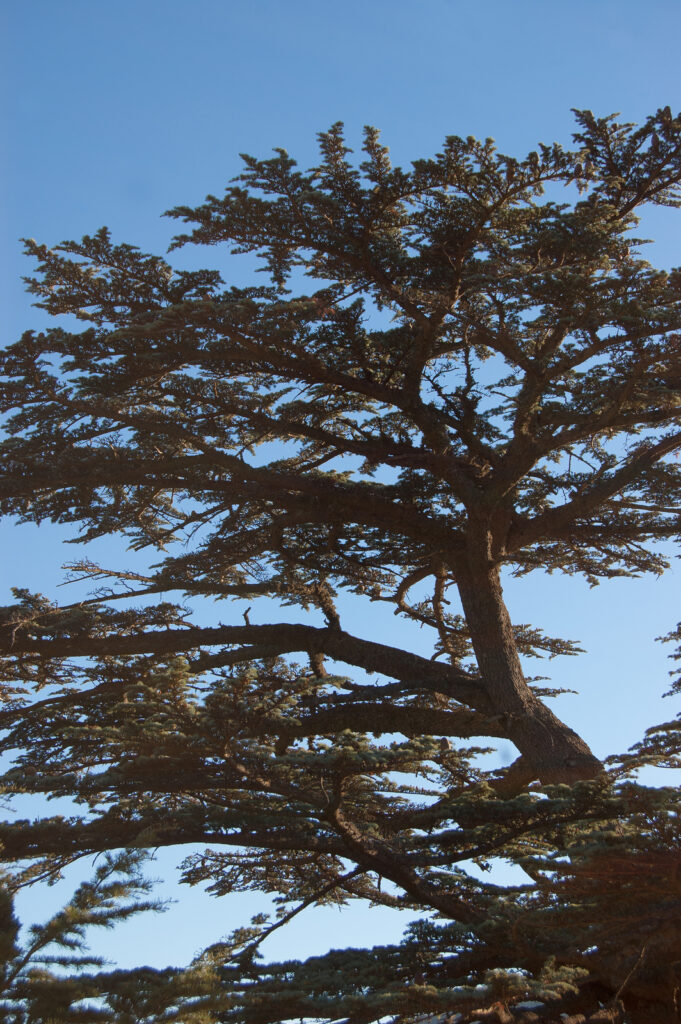Cedars are evergreen conifers that demand plenty of space at maturity. Branches are mostly sweeping, some pendulous. When other trees have lost their leaves in winter, cedars will dominate the landscape. Cedars are native to the Middle East; they will tolerate sandy and clay soil and summer heat.
Cedar is the common name for the coniferous genus Cedrus. However, cedar is often applied as a descriptive adjective to trees or plants in other genera including Canoe-cedar (Thuja plicata), Incense cedar (Libocedrus), Red cedar (Juniperus lucayana), and white cedar (Chamaecyparis thyoides).
Several species of the true cedar and many varietal forms of the red and white cedars provide much of the ornamental evergreen material used in gardens, parks, and cemetery plantings.
The four species of Cedrus of Asiatic and North African origin provide large wide-spreading evergreen trees with stiff needles in clusters and small erect cones. these are Atlas Cedar (C. atlantica) with feathery bluish-green leaves less than 1 inch long and Deodar Cedar (C. deodara) with graceful drooping branches, leaves to 2 inches long and 5-inch cones, and also Cedar of Lebanon (C. libanotica) with dark green 1-inch leaves and cones to 4 inches long.
See Varieties below for a list of plants that are not true cedars but that are commonly called cedars.
Get to know Cedrus
- Plant type: Evergreen coniferous tree
- Growing Zones and range: Zones 7-9
- Hardy: Plant where winter temperatures do not fall below -30°F; cedars tolerate heat and poor soil
- Height and spread: to 130 feet (40m) tall and 30 feet (10m) wide depending on the variety
- Foliage: Needle-like leaves to 2 inches (60mm) long can be grass green, dark green, or blue-green
- Uses: Specimen tree in large landscapes, screening
- Common name: Cedar
- Botanical name: Cedrus spp.
- Family: Pinaceae
- Origin: Forests of W. Himalayas and Mediterranean
Where to plant Cedrus
- Plant cedars in full sun. Allow ample room for trees to mature.
- Plant cedars in humus-rich, moisture-retentive, and well-drained soil.

When to plant Cedrus
- Transplant container-grown or balled-and-burlapped plants in spring or autumn.
Planting and spacing Cedrus
- Space cedars with their mature size in mind, as much as 30 feet (10m) apart.
How to water and feed Cedrus
- Keep the soil evenly moist.
- Spread aged compost below cedar trees to enhance soil nutrients and promote drainage.
Cedrus care
- Stake cedars the first year until they are established.
- Remove a competing leader early; after that, no pruning necessary.
Cedrus common problems
- Branches and foliage may be damage by strong winds.
- Too much fertilizer will promote succulent growth attractive to aphids.
- Cedrus is susceptibel to root rot, needle blights, stem cankers, and dieback.
- Cedurs can be attached by scale insects, pine sawfly, mealybugs, and caterpillars.
Cedar propagation
- Sow seed in spring.
- Take cutting in fall.
- Graft in spring.
Cedar varieties to grow
- Cedrus atlantica, Atlas cedar: Zones 6-9; grows to 130 feet (40m) tall and 30 feet (10m) wide; conical early becoming more open with age; fissured silvery gray bark; sharply pointed, 4-sided, dark green, glaucous blue leaves; cultivars incude ‘Aurea’ with golden yellow foliage when young maturing to green and ‘Glauca Pendula’ with penden, glaucous blue-green foliage.
- Cedrus deodara, Deodar cedar: Zones 6-9; grows to 130 feet (40m) tall, 25-30 feet (10m) wide; graceful, pendulous branching; mature trees widen and become flat-topped; green foliage is silvery with hints of blue; older trees produce green cones that turn reddish-brown when mature.
- Cedrus libani, Cedar of Lebanon: wide-spreading branches, conical when young, flat-topped when old; bark is black or brown with scaly fissures and ridges; sharply poined, dark green to gray-green leavew borne in whorls; cultivar ‘Glauca’, Blue Atlas cedar: Zones 6-9; 40-60 feet tall, 30-40 feet wide; sweeping branches with long-curving, silvery-blue needles; ‘Pendula’ has weeping form.
“Cedars”: Plants called Cedar, but not true Cedars
Red cedar (Juniperus virginiana) grows to 100 feet with wide-spread or upright branches, also dwarf columnar cultivars frequently used for bordering or framing vistas or background planting.
Colorado or Rocky Mountain Red Cedar (Juniperus scopulorm) grow to 30 feet or more and otherwise similar to Red Cedar.
Southern red cedar (Juniperus lucayana) grows to 50 feet with a drooping form of light green foliage.
White cedar, sometimes called swamp cedar (Chamaecyparis thyoides) grow to 80 feet, thrives in moist soil, often planted as a screen.
White cedar (Tabebuia pallida) grows to 50 feet tall with large white, pink, or rose flowers to 3 inches long.
Arbor-vitae, also called White cedar (Thua occidentalis) grows to 60 feet and is suitable for backgrounds, hedges, accents; dwarf forms can be used for foundation plantings.
Canoe cedar, red cedar (Thuja plicata) grows to 200 feet has drooping fern-like branches; can be closely sheared.
Cigar cedar, also called Spanish cedar (Cedrela odorata) grow to 100 feet is a tropical tree that bears yellowish flowers in loose clusters.
Incense cedar, also called Western cedar (Libocedrus decurrens) grows to 200 feet in a somewhat narrow graceful head with light yellowish-green foliage.
Ground cedar (Lycopodium complanatum) which is not a cedar but a ground moss.
Stinking cedar (Torrey taxifolia) grows to 40 feet, spreading tree, member of the yew family; when foliage is bruised it emits a fetid odor.



